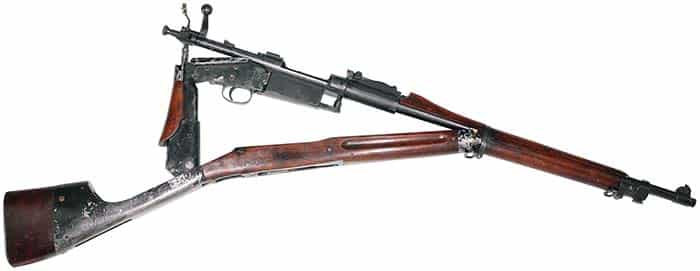By Michael Heidler
In the trenches along the frontlines of World War I, any look over the parapet could be the last one. On both sides snipers were waiting for their next victim. But how should one observe a target without exposing himself to this danger? The supposed solution came in the form of periscopes.
Thanks to these devices it was possible for the soldier to aim with the standard rifle sight, but without raising his head above the safe cover of the trench. Probably every participating nation tried to develop such devices, and some of the better designs were then manufactured industrially in (small) series.
When the United States of America entered the war, two inventors were just about to market such a device: James L. Cameron and Lawrence E. Yaggi, both from Cleveland in the northeast of Ohio, were well informed about the circumstances and dangers at the European theatre of war. Their idea consisted of a metal frame, resting on the shooter’s shoulder and raising the rifle over his head. Bolt and trigger could be manually operated by means of a lever mechanism. A simple periscope was attached to the rear of the device to aim over rear and fore sights of the rifle.
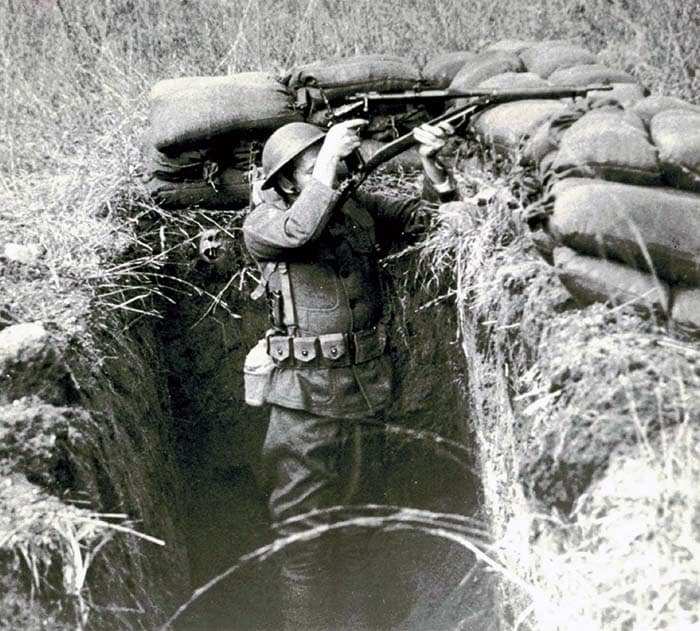
Cameron and Yaggi were able to complete a working prototype before America’s entry into the war. They travelled to Europe and visited British and French troops at the front. Although both nations experimented with such devices themselves, the American device left a very good impression. Yaggi reported that the German soldiers were searching for sunlight reflections from enemy trench periscopes and then waited for a careless soldier to expose his head. The “Cameron-Yaggi,” as the device was called in the absence of a model designation, would help to remedy this situation.
With many suggestions for improvements and their heads filled with ideas, both gentlemen returned to America. They immediately began to rework their invention. But shortly after their arrival at home, the United States entered the war in April 1917. Cameron and Yaggi realized that the U.S. Army would soon need such an aiming device. In order to convince the military decision-makers, an adaptation to the then-standard rifle M1903 (.30 caliber) was indispensable. A first, contact with the Ordnance Department led to the realization that there was no interest in military accessories, which would require a permanent modification of the weapons. This specification, however, played into the hands of Cameron and Yaggi, as their design required only the removal of the stock screws for attaching the mount of the periscope to the left side of the rifle stock. This conversion could be reversed quickly and left no lasting traces on the rifles.
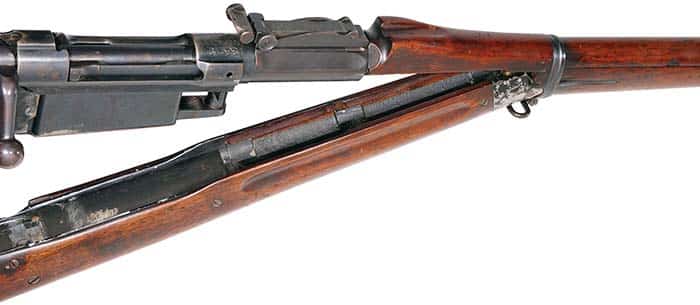
The Cameron-Yaggi is a relatively simple design made of metal tubing, similar to the frame of a bicycle. Over the months several more or less different variations were produced, and no two of the today existing devices are actually identical. The rifle is placed into the framework from above, so that the butt stock is supported at its rear by a suitably shaped piece of sheet metal. A screw clamp around the neck of the stock holds the gun firmly in its position. Some parts of the framework were wrapped with leather padding. The shooter had to grasp the device firmly with both hands. A standing position with no support was possible, but using the parapet of the trench as a support increased the hit probability considerably. The left hand of the shooter held the fixed front grip. The trigger of the device, which was connected to the trigger of the rifle by means of a rod assembly, was operated with the right hand.
One major difficulty of rifle periscope devices was the procedure of feeding the next round. The cocking handle of a bolt-action rifle had to be operated manually from cover in order to extract the empty case and to feed a new round into the chamber. There were no self-loading rifles in active front-line service at that time. And it would not have been practical to retract the bulky periscope device into the trench after each shot to reload the rifle and then push the device back into position. Cameron and Yaggi, therefore, designed a side-mounted frame that could slide back and forth. The cocking handle of the rifle was clamped into a mount at the top of this frame. Below, the framework had its own cocking handle, and both were connected with a rod to transfer the movements. In order to increase the weapon’s sustained fire capability, the special 25-round extension box magazine of the Air Service M1903 could be attached to the weapon. However, this was a fixed magazine, and it remained permanently on the weapon.
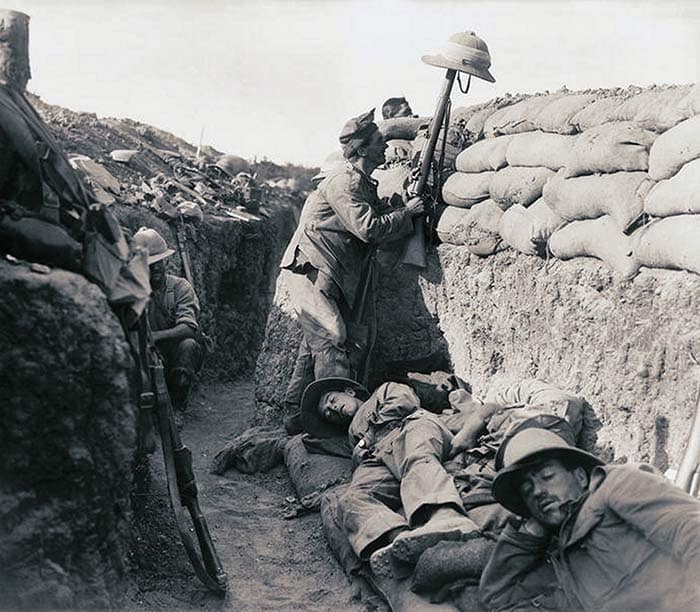
On the left side of the rifle a dovetail mount was attached. The periscope, inserted into this mount, could be easily removed for transport at any time. This optical device was named “Sightascope” by its inventors and proved surprisingly precise: during a demonstration of the device in front of Ordnance Department representatives, 10 rounds were fired at a target at 200 yards (180 meters) distance. The dispersion was only 1.3 inches (33cm). Windage and elevation could be adjusted by two rotary-type knobs. The still-existing devices show marks from 1X to 4X, suggesting experiments with different magnifications. However, all have the same cross-hair reticules. The lens is recessed in the housing to reduce sunlight reflections, which notoriously attracted the attention of enemy snipers.
At first glance, the bulky Cameron-Yaggi device looks very heavy, but it actually weighs only about 6 pounds (2.8kg). The total weight together with a Springfield M1903 was 14.7 pounds (6.7kg). And it was not meant for movement during combat or longer marches. Rather, it should be used in static positions in the front line trenches.

After a few changes to the design, Yaggi was able to demonstrate the periscope device at the Marine Corps Rifle Range in Winthrop/Maryland in summer of 1917. One of the spectators, Colonel C.B. Winter, tried the device by himself and wrote a small report. He was expecting a hard recoil because of the powerful cartridge. But he was mistaken—the recoil was much less than firing a round with the standard rifle. The framework of the device absorbed most of the recoil force.
After the successful demonstration, Cameron and Yaggi were at that time confident that their invention would soon be accepted by the Ordnance Department. They even designed variants for the M1917 rifle and the air-cooled Lewis light machine gun. But unfortunately nothing happened. The department let the matter rest, until the war finally ended in November 1918.
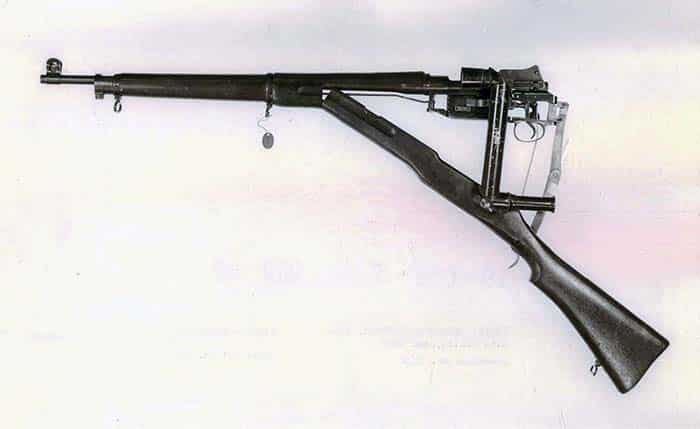
But other similar devices were still far less successful and did not even get shortlisted. Like the invention of Mr. Guiberson from California. He did not design a bulky frame for holding a rifle, but integrated the periscope device into the weapon itself. The cost of the conversion was enormous and was completely in contradiction with the specifications of the Ordnance Department. But the result was a very well thought-out design. When collapsed, the “Guiberson Rifle” hardly differed from the standard M1903 rifle. If necessary, the rear half of the specially modified stock could be unlocked and folded down. This part is connected to the system by means of a robust support which rests in the hollow stock when not in use. The support is pulled out automatically during the unfolding and thus stabilizes the weapon in the combat-ready condition. In addition, a small mirror is attached to its base. The soldier can look through an elongated opening within the support at a second mirror at the top of the support and thus on the rear and fore sights. For firing, the trigger of the rifle is used, but nevertheless the hand of the shooter still remains below the parapet of the trench. Apart from the M1903, Guiberson also converted a few M1917 rifles. He also experimented with hollowed-out wooden stocks as well as in combination with stock sections made of sheet metal. At least one converted M1917 was made with a small folding support and got a separate periscope attached to its left side.
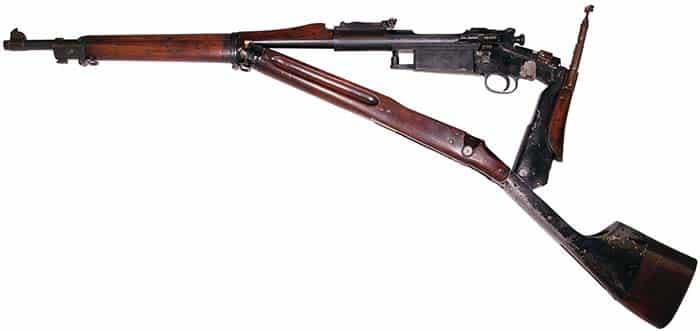
A short report written by Captain Edward C. Crossman in April 1917 about a demonstration of the Guiberson rifle at the Ordnance Department gives us some insight: “The upper mirror is carried by a detachable but still out of the way steel bar, which slides into a slot cut in the receiver on the left side. Gazing in the bottom mirror of the rifle periscope, you see merely the two sights, the target and say 30 feet of field at 200 yards. The curious ones present at the trials, had no trouble in swatting regularly the silhouette at 200 yards, although the too-narrow service sight is still worse with this form of sighting apparatus. Queerly enough there is little kick […]. The shape of the grip portion is not quite right, and several of us got nice raised and purple spots on the forehead from contact with this. Avoiding this, the rifle seemed to kick but little; less than the direct drive of the regular arm.”
How many Cameron-Yaggis and Guibersons were produced at the time is not known. Today there are still a few surviving pieces in museums and private collections. However, they were never able to prove their suitability in the hard daily life of the trench warfare.
Thanks to curator Alex MacKenzie (Springfield Armory NHS) for his support.
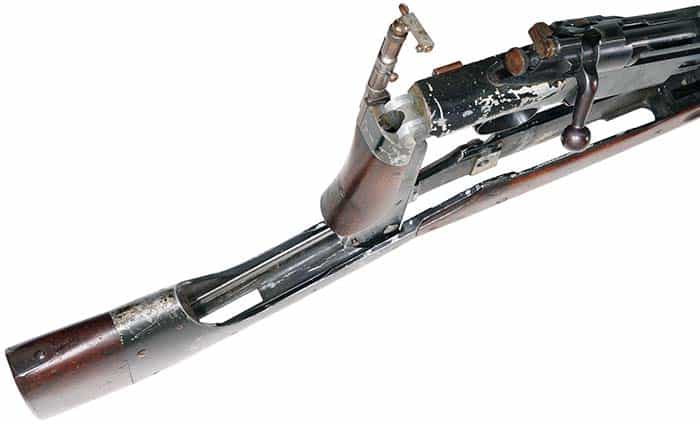
| This article first appeared in Small Arms Review V21N9 (November 2017) |



